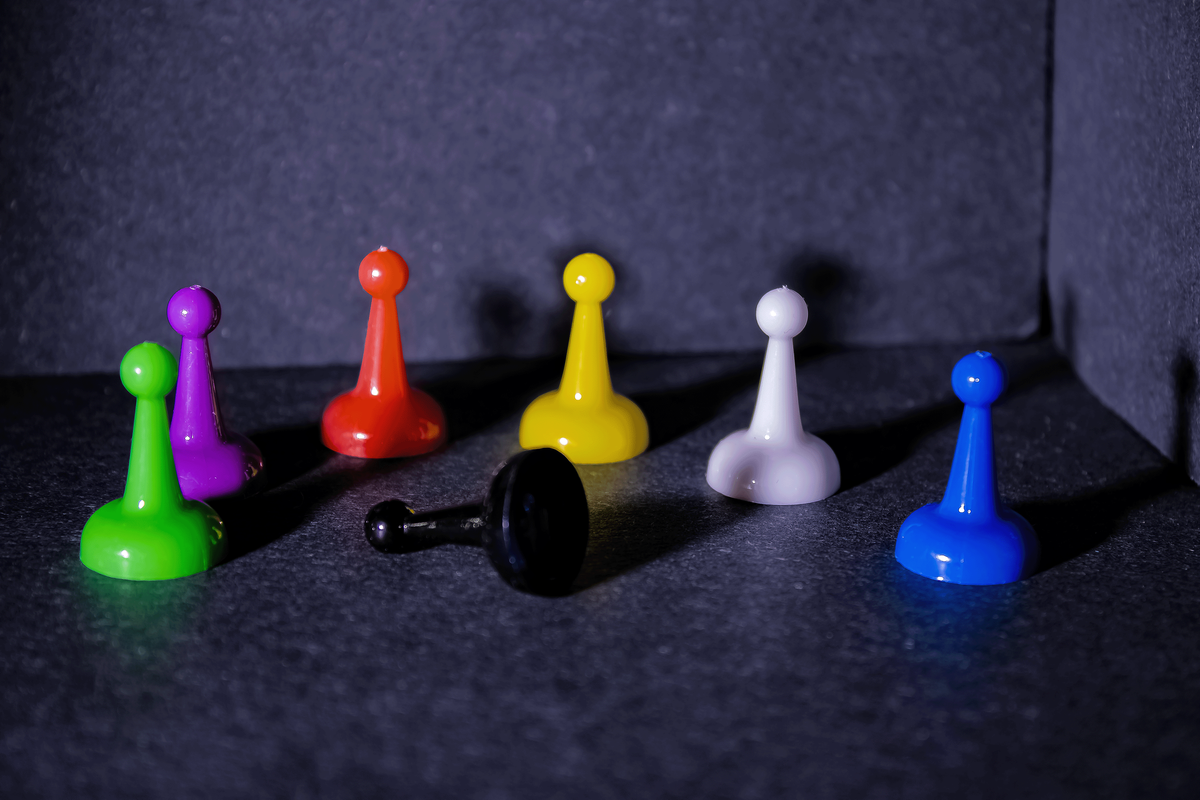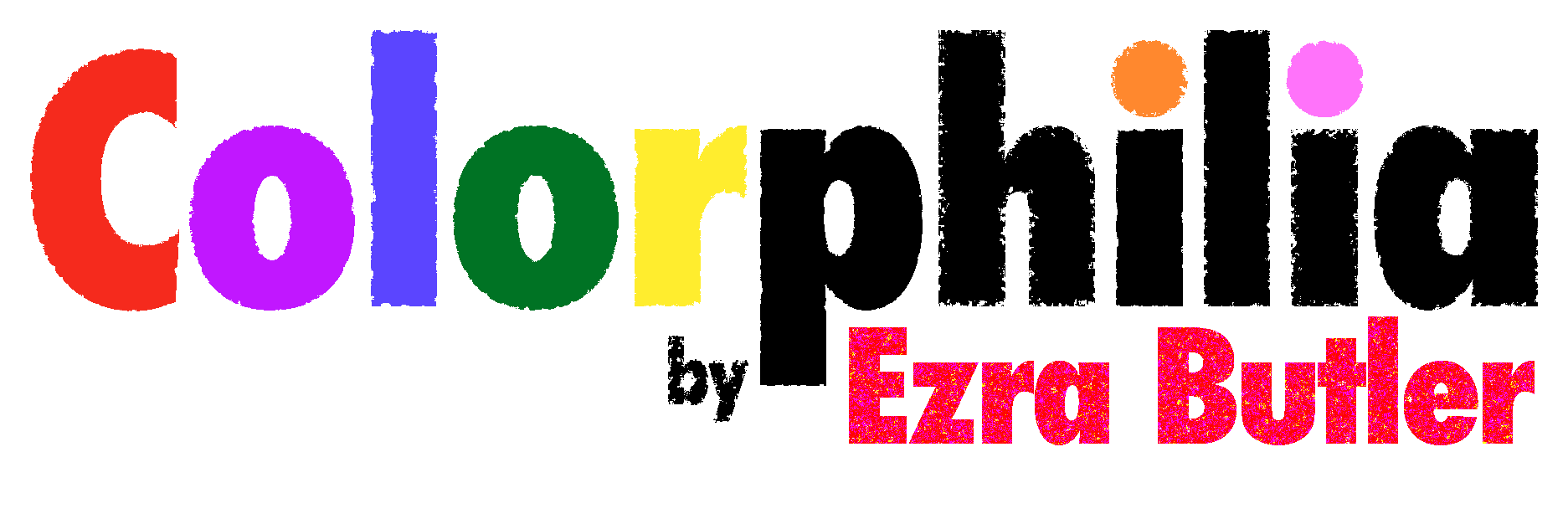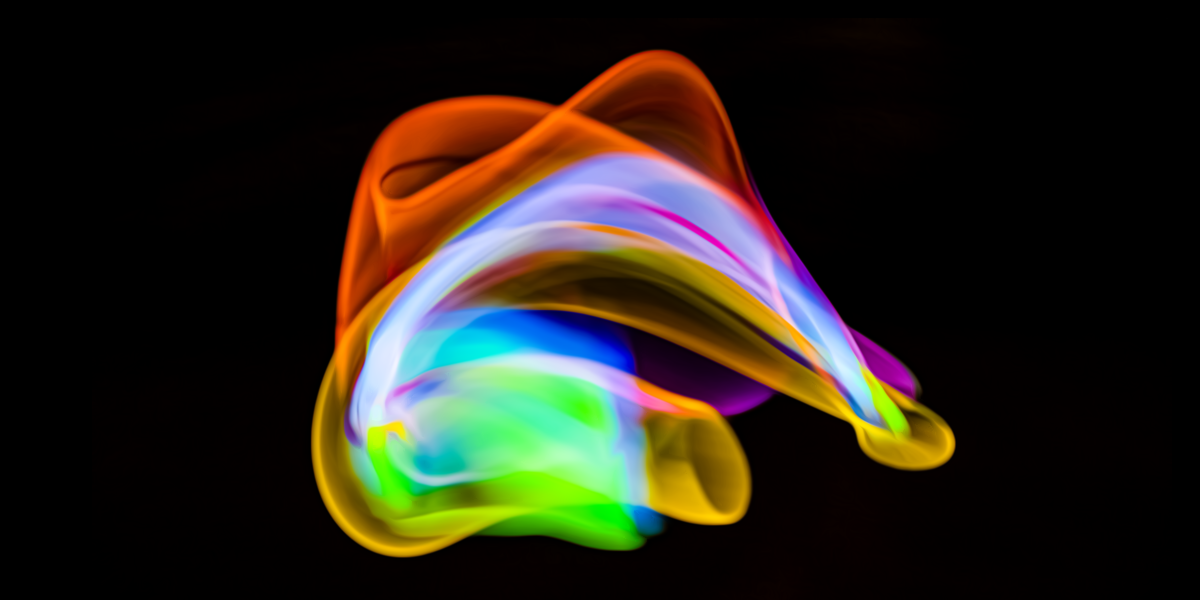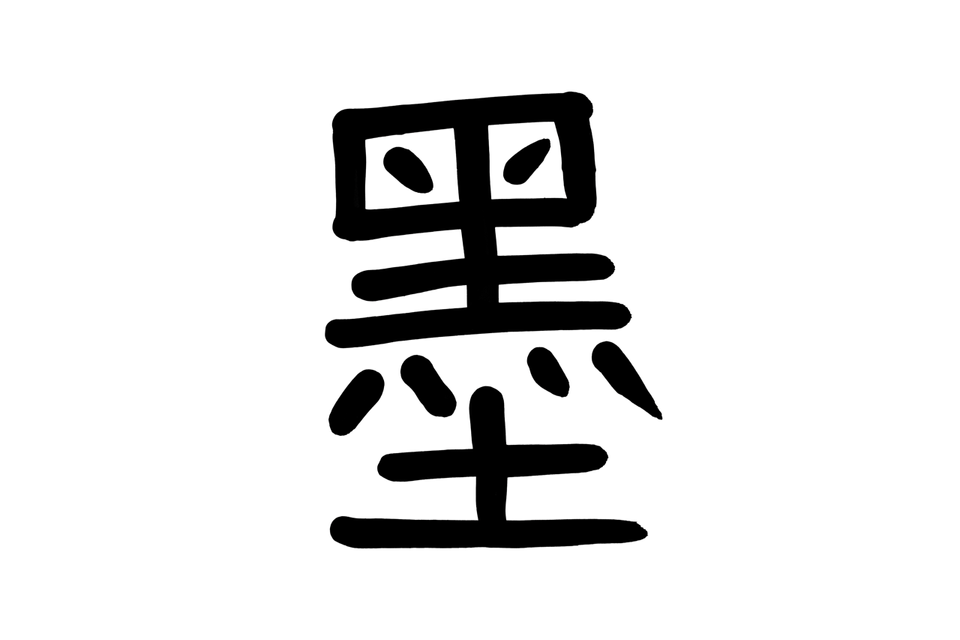Playing with Color: Clue, Croquet, and Billiards
This also discusses scientists and color.

Around a month ago, I attended a "Nerd Nite Chicago" in which speakers from different backgrounds spoke about random topics. The first one, a linguist, spoke about the etymologies of "pumpkin" and "spice". The third one, a quantum physicist, spoke about climate change, black bodies, and green house gasses. The second one spoke about strategies on how to win Clue.
In that spirit: Somehow I started researching Clue and color, which logically led to croquet, and somehow ended up with discovering an atomic billiard table.
Clue(do)
For the uninitiated, "Clue" (or in England, "Cluedo") is a murder mystery board game in which each player attempts to ascertain who is the culprit, in which room did they commit the murder, and which weapon did they use. There are six suspects, nine rooms, and six weapons; which meant that mathematically, there are 324 possible permutations or outcomes for the game of Clue.
Cluedo was invented in Birmingham, England in the 1940s by a couple named Elva and Anthony Pratt, as an attempt to keep sane during the German Luftwaffe's Blitz. It was their version of Shakespeare writing epic poetry during the plague.
But like Shakespeare's poem "Venus and Adonis", the inspiration came from various earlier sources. Murder mystery games were en vogue in the 1930s, and the board game aspect of was borrowed from a game which originated in Ancient India called "Pachisi".
Pachisi
"Pachisi" was adapted in the mid-19th century as "Parcheesi" in the United States and in the late-19th century as "Ludo" in England, which is the reason why Clue has different names on the different sides of the pond. (Pachisi simply meant "25" in Hindi, because of the way the game was originally played throwing cowrie shells (a sort of sea snail) and moving the number of spaces on the board.)
The goal was for each player or team to move all of its pieces around the board. Each player's pieces were distinguishable by their uniform color: black, green, red, and yellow. But those colors are somewhat subjective. People would recreate the game with whatever they could find, usually with color as the distinguishing factor. They would use stones, seeds, shells, or anything else they could find, which would be small enough to fit on a game board, but in a large-enough quantity for each color. In comparison, Ludo's four colors were typically yellow, green, red, and blue.
While Pachisi, Parcheesi, and Ludo all have slightly different variants, and it is obvious that Cluedo and Clue features different game mechanics, the direct line of inspiration is clear. The Pratts used their Ludo pieces and board to design their game.
Colorful Characters
The names of the six archetypical characters in Clue have changed a little through the years, but have always remained interpretations of the player's color token or figurine.
• Red - Miss Scarlett
• Yellow - Colonel Mustard
• Green - Reverend Green / Mayor Green / Mr. Green
• White - Mrs. White / Dr. Orchid / Chef White
• Blue - Mrs. Peacock
• Purple - Professor Plum
The victim was Dr. Black or Mr. Boddy, inspired by the color black.
During its many iterations of board games, video games, television series, and movies, additional players and victims have been created, usually featuring a color-word as their last name. These words include: celadon, hyacinth, coral, ube, rose, azul, umber, ruby, lavender, azure, gray, brown, slate-grey, rose, brunette, and peach, among others.
As a researcher of color, narratology, and creativity, I find the evolution of creating characters from the available color tokens to be an inspired storytelling process. The fact that one could say "yellow, that's mustard, he must be a colonel, and is therefore, gruff and no nonsense." Or to construct a scenario which would bring them all to the same residence is an example of increased creativity through constraints.
For instance, I recently rewatched the 1985 classic "Clue" featuring Tim Curry, which explains the colors as given pseudonyms, as all of the characters were being blackmailed. True to the board game, the movie offered various possible endings at different theatres, but the home release includes all three.
There is little I can say about the movie other than, "Clue is a camp reinterpretation of the idea of a color war."
Which is to say that it is quite delightful.
Colorful Croquet
The Pratts and Cluedo were one in a long-tradition of borrowing pieces and creating something new.
There had been versions of games since before the 13th century, both on a table and on the ground, in which a player would hit a ball with some sort of stick or mallet. The size and number of the balls, the goals, and the hitting implement would all change. But each one would invariably be created because people had implements from an eariier version of the game.
Croquet, a game played with colorful mallets and wooden balls on a lawn, was invented in the mid-1850s. In the earliest sources I could find, I kept discovering them referring to the wide variety of colors on the green grass.
Paint them of as many colours as there are balls.
The more vivid the colour, the prettier will be the effect on the green sward, and the pleasanter the play.
Croquet - Captain Mayne Reid - 1863
Players would be called by their colors, because people just didn't know other people's name.
...croquet is often played by people - not only thitherto, but thenceforth -strangers to each other.
The more social an activity, the more likely it is to contain more colors. Chess and checkers are both two players, and only required two colors. As we saw with Pachisi, four distinct colors were needed to include more players.
A slightly later American source notes:
The best and most attractive manner of painting the balls is to paint four dark, and four light. It is a matter of choice whether the balls are painted all over, or merely a single stripe placed around them. In either case the dark balls are as follows: one blue, one black, one brown, and one green; and the light balls: one white, one yellow, one orange, and one red.
How to Play Croquet - American Version - 1873
Atomic Croquet
Over the past year, I've been discovering scientists and polymaths of all sorts, usually completely on accident. August Wilhem von Hofmann is one of those personalities. Though he was German in nationality, he was hired in 1845 to be the first director of the new British Royal College of Chemistry, and would remain there for two decades.
I came across some of his writing when I realized that he was the first scientist to use color in atomic models. In fact, the first source is from his final lecture, April 7, 1865, at the Royal Institute's Friday Evening Discourses, in the presence of the 23 year old Prince of Wales, the future King Edward VII.
In the talk titled "On the Combining Power of Atoms", Hofmann created a series of models of atoms using the croquet balls, which he described as the "most delightful of games":
I will on this occasion, with your permission, select my illustration from that most delightful of games, croquet.
Let the croquet balls represent our atoms, and let us distinguish the atoms of different elements by different colours. The white balls are hydrogen, the green ones chlorine atoms; the atoms of fiery oxygen are red, those of nitrogen, blue; the carbons atoms, lastly, are naturally represented by black balls.
Many atomic models still follow his coloring scheme, which was borrowed by colors available for croquet in the early 1860s..
Midcentury Colorphilia
I've previously mentioned how the period of the 1850s and 1860s was marked with an enthusiasm about new color, due to the synthetization of aniline (or coal-tar) colors, like mauve and magenta. This represented a new variety of colors previously not found in nature, which also resulted in much more inexpensively manufactured pigments.
In fact, working on Hofmann's research, it was one of his assistants, an 18 year old British chemistry student named William Perkins, who discovered a purple aniline dye during a failed quinine experiment. Perkins applied for a patent in 1856, dropped out of school, and became a dye entrepreneur. He tried to market it as "Tyrian purple", which is really more of a pomegranate, and chose the name "mauveine" or "mauve".
By 1859, there was a mauve fever.
As I look out of my window, the apotheosis of Perkin’s purple seems at hand—purple hands wave from open carriages—purple hands shake each other at doors—purple hands threaten each other from opposite sides of the street; purple—striped gowns cram barouches, jam up cabs, throng streamers, fill railway stations: all flying countryward, like so many migrating birds of purple Paradise.
– Charles Dickens, "All the year round", September 1959
Hofmann shifted to researching color from coal, starting with rosaline in 1858, and by 1863 had created a whole variety of blues and purples, called "Hoffman's Violets", and created quinoline red in 1887.
In fact, the first talk Hofmann gave to the Royal Institute's Friday Evening Discourses was in April 11, 1862, delivering a paper called "On Mauve and Magenta" in which he described the process that it took to create these exciting new colors.
Briefly expressed, the aim of this address may be said to be, to show you the way from coal to colour.
He did note something the financial value of mauve:
This brown lump, with the remarkable coppery lustre, is Mauve in the solid state; its extraordinary tinctorial powers will be appreciated, if I tell you that this beautiful violet-coloured solution contains not more than 1/10 of a grain of Mauvein one gallon of alcohol; you will also understand the considerable commercial value of this substance. Weight for weight, I am told by Mr. Perkin, this colouring matter, when pure, is sold at the price of metallic platinum.
But one of the beautiful parts of the talk is in the final paragraphs. It was the final year that Michael Faraday organized the Friday Evening Discourses, and Hofmann recognizes Faraday's discovery of benzol 37 years earlier.
Benzol has furnished us Mauve and Magenta, but it has done much more than this. Ever since chemistry became endowed with this wonderful body, benzol has been the carrier of many of the leading ideas in our science. In the hands of Mitscherlich, Zinin, Gerhardt and Laurent, in the hands of Charles Mansfield- never to be forgotten by his friends- and many others, benzol has been a powerful lever for the advancement of chemical science. Benzol and its derivatives form one of the most interesting chapters in organic chemistry, the progress of which is intimately allied with the history of this compound.
But what has the history of benzol to do with the moral of Mauve and Magenta?
Whenever in future one of your chemical friends, full of enthusiasm, exhibits and explains to you his newly-discovered compound, you will not cool his noble ardour by asking him that most terrible of all questions, "What is its use? Will your compound bleach or dye? Will it shave? May it be used as a substitute for leather?"
Let him quietly go on with his work.
The dye, the lather, the leather will make their appearance in due time. Let him, I repeat it, perform his task.
Let him indulge in the pursuit of truth, - of truth pure and simple - of truth not for the sake of Mauve, not for the sake of Magenta - let him pursue truth for the sake of truth!
Atomic Probabilities
Games and the sciences are interconnected in many ways.
Probability
Blaise Pascal and Pierre de Fermat were 17th century mathematicians and gamblers, who invented probablity theory in order to figure out what the best way for two gamblers to fairly end a game early.
AI
Chess and Go are two of the games which early computer programmers and researchers would use to test and benchmark "artificial computer intelligence".
The 1983 Cold War film "WarGames" was inspired by the ability of computers to calculate probabilities and nuclear war. Two years later, the American technology company IBM began developing Deep Blue, a supercomputer with the sole purpose of being good at chess. In 1996, the Deep Blue lost to Russian chess grandmaster Garry Kasparov 4-2. But in 1997, in a rematch, it beat Kasparov by winning 2 matches and drawing 3.
Atomic Billiards
Some of the first synthetic resins were created because of games.
Billiards is a game of physics. It’s been mentioned many times that billiards was an example of Newtonian physics, and then of fluid dynamics.
It's a great example of a game whose many variants were based on the availability of materials or game pieces, and in what colors. While we are most familiar with the colorful 9 ball variety of pool played now, with the solids and the stripes to indicate ball numbers, most earlier variants were used much fewer balls, and in much fewer colors, usually white and red or yellow. Paint was problematic on the billiards balls, because it would change the weight and precision of the sphere.
By the late 1860s, billiards was such a popular game, but the perfect material for the ivory balls were made from elephant tusk, each only able to create eight balls. The material mattered because billiards is a game based on physics, force, and angles, and if you don't have a perfect sphere with a good density, you will not be able to play correctly.
One of the earliest predecessors to plastic, an ivory imitation composite was patented in 1869 by John Hyatt, made from nitrocellulose, camphor and ground cattle bone, for the purpose of making billiard balls.
While we saw that Hofmann used croquet balls to build atoms, other science writers have used billiard balls as an model of how atoms and electrons interacted.
In 1861:
just as a rolling billiard ball makes another ball move too, by striking upon it, losing some part of its own motion in the act of communication, so the pulsating molecules set neighbouring molecules trembling in the same way with themselves, and lose just as much pulsatory movement as they communicate.
In 1925:
People have not hesitated, therefore, to materialise the atom of electricity, the electron, under the form of a small sphere capable of being eventually transformed into an ellipsoid. The radion, the quantum of Planck, is now being subjected to the same transformation; some people are already able to see it as a small billiard ball capable of colliding with an electron and of deflecting it while recoiling.
In 1949:
A very simply conception of an atom and one that gives a surprisingly good picture of its behavior is to think of the atom as a submicroscopic billiard ball. The atoms of the air traveling with speeds of a thousand miles an hour collide and bounce off one another in a way much like myriads of balls heading in all directions might do.
And finally, they created atomic-scale billiard table.
In 2007:
A game of billiards may never get smaller than this. Physicists at UC Riverside have demonstrated that graphene – a one-atom thick sheet of carbon atoms arranged in hexagonal rings – can act as an atomic-scale billiard table, with electric charges acting as billiard balls.




